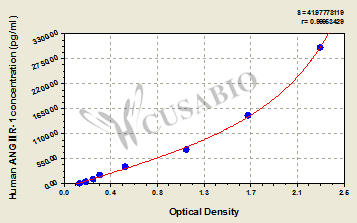The human AGTR1 ELISA kit is a solid-phase immunoassay specially designed to quantitatively measure human AGTR1 in serum, plasma, tissue homogenates, or cell lysates. It is based on the Sandwich-ELISA mechanism. AGTR1 in the sample is bound to the capture antibody immobilized on the 96-well strip plate and then sandwiched with the biotinylated AGTR1 antibody. After the addition of HRP-avidin and TMB substrate, the solution in the wells turns blue. The color reaction is stopped by adding the stop solution into the wells, and the color changes from blue to yellow. The color intensity is positively proportional to the AGTR1 bound in the initial step. The AGTR1 concentration can be calculated according to the standard curve. This kit is tested with high sensitivity, strong specificity, good linearity, high precision and recovery, as well as lot-to-lot consistency.
Angiotensin II (ATII) interacts with AGTR1, which causes calcium-dependent phosphorylation of myosin, leading to vascular smooth muscle contraction. This arterial smooth muscle contraction is responsible for raising blood pressure. AGTR1 is mostly found in vascular smooth muscle cells, as well as the heart, adrenal gland, and kidney. It is involved in the etiology of hypertension and plays an important role in blood pressure management. The majority of evidence points to AGTR1 as a possible cause of pathologic conditions like hypertension. Angiotensin receptor blockers that target AGTR1 are routinely prescribed antihypertensive drugs that have been demonstrated to minimize the risk of other cardiovascular outcomes in addition to lowering blood pressure. As such, AGTR1 is an excellent candidate gene in the etiology of hypertension and other cardiovascular diseases (CVD).






